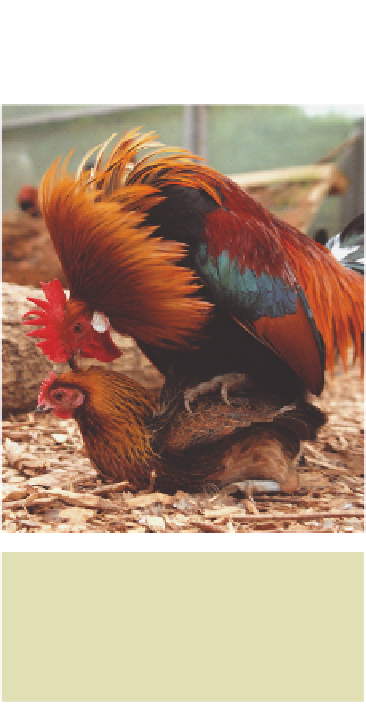Biology Reference
In-Depth Information
adders (
Vipera berus
) lose as much body mass
during spermatogenesis (when they
are inactive) as during the subsequent phase
of searching and competing for females
(Olsson
et al
., 1997).
It is not surprising, therefore, that
males allocate their sperm strategically in
response to both sperm competition and
female fecundity (Wedell
et al
.,
2
002).
The study by Tommaso Pizzari
et al
.
(2003) of a free-ranging population of
feral fowl
Gallus gallus
provides an
excellent example (Fig. 7.21). They
collected ejaculates by fitting females
with a harness and the sperm were then
counted. Dominant males increased their
sperm investment in a female when there
were more male competitors and they
allocated more sperm to females with
larger combs, which laid larger eggs.
Furthermore, a male's sperm investment
declined with repeated exposure to the
same female but was renewed by the
arrival of a novel female. This is known
as the 'Coolidge effect', named after
President Coolidge - during a visit to a chicken farm with his wife, when Mrs.
Coolidge was told that a rooster could copulate dozens of times each day she is
reported to have said: 'Tell that to the President'. The President then enquired
whether this involved the same hen every time, and was informed that many different
hens were involved. 'Tell
that
to Mrs. Coolidge!', he replied.
Sometimes males become sperm depleted and this can reduce female fertility. In
blueheaded wrasse (
Thalassoma bifasciatum
), a coral reef fish, dominant males attract the
most females but females suffer fertility costs when pairing with these males because
they release fewer sperm per mating (fertilization is external; Warner
et al
., 1995). Sperm
limitation of attractive males can lead to competition among females for mating access.
In the great snipe (
Gallinago media
) females compete for repeated copulation with the
most popular males on a lek, but males reject females with whom they have already
mated (Saether
et al
., 2001).
Males vary sperm
allocation in
response to
sexual
competition
Fig. 7.21
A pair of feral fowl
copulating. The female is fitted with a
harness, so sperm can be collected after
a mating to measure the ejaculate.
Photo © Charlie Cornwallis.
Sperm depletion
in males
Female adaptations
When Parker (1970c) first identified sperm competition as an important component
of sexual selection, researchers focussed on male adaptations because theory led
them to believe that success in post-mating conflicts was more important to a male
than to a female. Essentially, males were thought to play a 'numbers game', where
increased fertilization success leads to more offspring, whereas females played a
'quality game', where increased control of fertilization improved only offspring





























